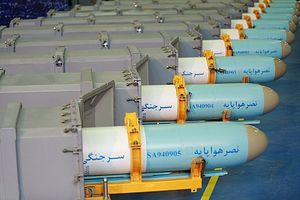Pakistan has claimed that it successfully conducted a “ training launch” of Nasr, a short-range surface-to-surface ballistic missile, last week. In addition to the statement, a video was released that showed four of these missiles being launched in a salvo.
According to the statement, which was put out by Pakistan’s Inter-Service Public Relations (ISPR) office, the test was conducted to beef up the operational efficiency of Army Strategic Forces Command as well as to validate the technical parameters of the missile. The statement noted that the missile has the ability for “in-flight maneuverability” and claimed that it has given a boost to Pakistan’s “full spectrum deterrence.”
There is little doubt that the Nasr is directly focused on complicating India’s nuclear doctrine and the Indian Army’s efforts to create a space below the nuclear threshold for conventional operations through the “Cold Start” doctrine.
The Indian doctrine came about as a result of not having an effective response in the wake of the December 2001 terrorist attack on the Indian Parliament. India recognized that Pakistan’s nuclear status prevents it from conducting deep thrusts into Pakistan’s territory because it could lead to Islamabad responding with a nuclear attack.
Cold Start is designed to nevertheless use India’s conventional superiority to punish Pakistan by conducting a large number of shallow attacks into Pakistani territory. The hope is that the shallowness of such an attack will prevent Pakistan from finding a justifiable cause for using its nuclear weapons, while the width and number of attacks will both prevent Pakistan from being able to defend itself and allow India to capture some territory to force Pakistan to be amenable to Indian political demands, such as stopping Pakistani support for the insurgency in the Indian state of Jammu and Kashmir.
Pakistan wants to prevent such Indian plans by suggesting that it will respond with nuclear weapons to even limited-distance thrusts as envisaged under Cold Start. After a previous test launch of the Nasr missile in 2017, Pakistani army chief General Qamar Javed Bajwa is reported to have said that the “Nasr has put cold water on Cold Start.”
Pakistan started developing the Nasr in the mid-2000s and the first report about the missile came out after a test firing on April 19, 2011. The missile, capable of carrying a sub-kilo ton nuclear warhead, is a derivative of the WS-2 Weishi Rockets system developed by China’s Sichuan Aerospace Corporation.
Though the missile is likely to carry a small tactical nuclear warhead, analysts argue that “it is intended to serve the dual purpose of demonstrating Pakistan’s determination to protect its vital national interests; and to provoke international intervention to stop India.” Some Pakistani analysts are of the view that the Nasr TNWs can restrain India from carrying out “massive retaliation,” a principle enshrined in India’s nuclear doctrine and is “a cost-effective way [due to Pakistan’s resource constraints] to alleviate the rapidly growing conventional asymmetries between India and Pakistan and to counter the threat of limited war.” Pakistan feels that Nasr is also less provocative because it is not intended to be used on Indian territory but on Indian troops who are already deep inside Pakistan’s territory.
While there are still questions about whether Pakistan has managed to actually build warheads sufficiently small to fit on top of the Nasr missile, the United States has remained concerned about the heightened risk of a nuclear conflict with India with the introduction of the TNWs. Such weapons have to be forward deployed, and control of these weapons need to be delegated to lower levels of command, which increases probability of these weapons being used without being authorized by the central command. There is also an increased risk of these weapons even being stolen. Nevertheless, for Rawalpindi, the Nasr has probably performed its deterrence task by seriously complicating Indian war plans and nuclear strategy.

































